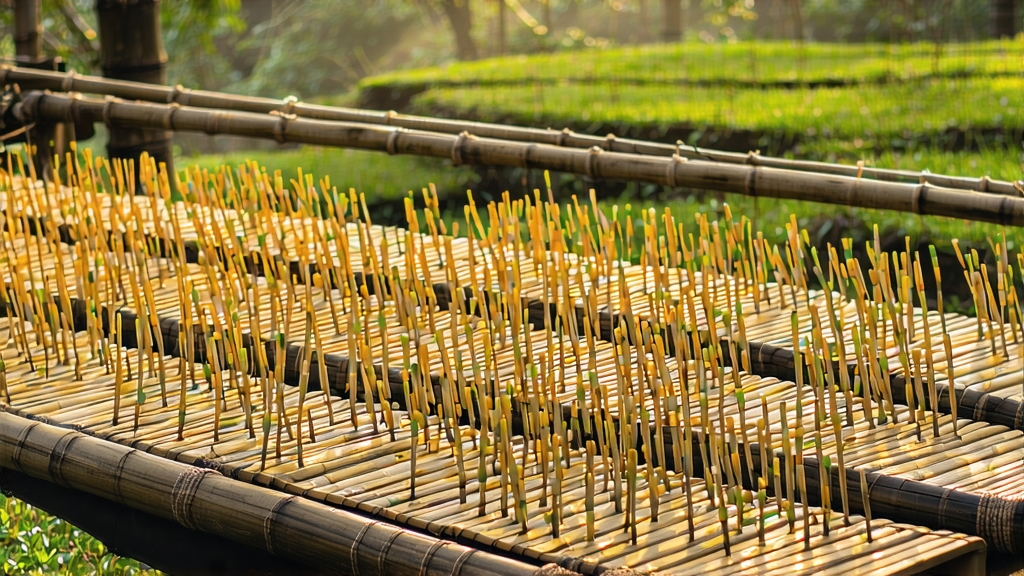
Tucked high on the mist-laden shoulders of Mt. Meng in Sichuan Province, Meng Ding Huang Ya has been quietly perfecting its golden character for more than twelve centuries. To most Western drinkers “yellow tea” is still a hazy category somewhere between green and oolong, yet this single bud-and-leaf variety embodies the entire philosophy of Chinese yellowing: a deliberate, patient coaxing of fresh leaf into a luminous liquor that tastes like mountain air translated into honeyed silk. Understanding Meng Ding Huang Ya is therefore the shortest path to understanding why Chinese emperors once guarded yellow tea as a palace secret and why modern connoisseurs now chase its elusive harvest before the spring equinox.
Historical whispers
The first written record appears in a Tang-dynasty county gazetteer (AD 724) describing “mengshan yellow sprouts” presented to the throne. By Song times the tea was measured in “beads of gold” rather than catties; Ming scholars praised its ability to “open the mind without disturbing the spirit.” When the Qing court moved to Beijing, caravans carried sealed earthen jars—each cushioned in bamboo leaves—2,200 km north, arriving with the buds still fragrant. The 1950s saw state plantations re-graft ancient mother trees, and in 2008 Meng Ding Huang Ya was re-certified as a National Intangible Cultural Heritage, ensuring the survival of its micro-fermentation craft.
Micro-terroir on the roof of Sichuan
Mt. Meng rises 1,450 m above the Chengdu plain, punching into a cloud belt that keeps relative humidity above 85 % even at midday. The soil is a crumbly quartz-rich yellow loam—locals call it “butter earth”—that drains quickly yet holds just enough moisture for the shallow-rooted tea bushes. Diurnal temperature swings of 15 °C slow amino-acid metabolism, concentrating the sweet compound theanine while keeping catechins low. The result is a bud that is already buttery before any human hand touches it.
Pluck: one open day in early spring
Only the “flag-and-bayonet” pluck is accepted: the unopened bud sheathed by a single tiny leaf shaped like a spear head. Picking begins when 5 % of the buds stand above the mist—usually between 5 and 15 March—and finishes within ten days. Experienced pickers work barefoot so they can feel the soil temperature; if it is colder than their palm they leave the bud for the next morning. A full kilogram of finished tea needs 42,000 such tips, roughly one hour’s work for six nimble fingers.
Kill-green with breath, not fire
Within thirty minutes of plucking the buds are slid onto bamboo trays pre-warmed to 38 °C, the temperature of a resting deer. A 90-second shaqing (kill-green) follows on cast-iron pans brushed only with spring water; the goal is to deactivate leaf enzymes while preserving 12–15 % residual moisture—far higher than green tea. The master’s wrist motion is a figure-eight, said to “close the gate but leave the window ajar,” a poetic way of describing partial enzyme survival.
Sealed yellowing: the 48-hour slow dream
The heart of yellow tea lies in menhuang, the sealed yellowing step. The lightly pan-fired buds are wrapped in thick canvas bundles and placed inside a pine-wood cabinet lined with wet rice paper. Every four hours the master unwraps, fluffs, and re-wraps, allowing a micro-oxygenic fermentation to bloom. During this phase chlorophyll gently oxidizes to pheophytin, turning the leaf colour from jade to old gold, while catechins dimerize into theaflavins that lend a honeysuckle note. The cabinet temperature is never allowed above 32 °C; higher would push the leaf toward black tea territory, lower would trap grassy greenness. After two nights the buds have lost another 20 % moisture and acquired a faint scent of raw cocoa.
Three-stage firing: locking the moonlight
The now-yellowed leaf is given a sequence of three low-temperature firings—65 °C, 55 °C, 45 °C—each lasting no longer than four minutes. Between firings the leaf rests on hemp cloth for an hour, allowing internal moisture to migrate outward. This stair-step drying caramelizes free sugars and fixes the signature “chestnut-burnt cream” aroma.